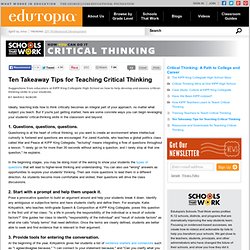

A Bloom's Digital Taxonomy For Evaluating Digital Tasks. 26 Sentence Stems For Higher-Level Discussion In The Classroom. 26 Sentence Stems For Higher-Level Conversation In The Classroom Meaningful conversation can make learning more personal, immediate, and emotional.

During meaningful conversations, students are forced to be accountable for their positions, to listen, to analyze opposing perspectives, and to adapt their thinking on the fly. There are many popular strategies for these kinds of conversations, each with slightly unique rules and applications. Among them are Socrative Discussions, Accountable Talks, Debate, and Literature Circles. Whichever strategy you employ, students need support. It is sometimes argued that the these kinds of conversations favor students that are confident expressing themselves verbally, and that’s hard to argue.
And all can benefit from scaffolding, so that students are given different levels of support–maybe unique tiers of index cards with easier to use or more natural stems–so that they can be successful on some level. Clarifying. Ten Takeaway Tips for Teaching Critical Thinking. Suggestions from educators at KIPP King Collegiate High School on how to help develop and assess critical-thinking skills in your students.

Ideally, teaching kids how to think critically becomes an integral part of your approach, no matter what subject you teach. But if you're just getting started, here are some concrete ways you can begin leveraging your students' critical-thinking skills in the classroom and beyond. 1. Questions, questions, questions. Questioning is at the heart of critical thinking, so you want to create an environment where intellectual curiosity is fostered and questions are encouraged. In the beginning stages, you may be doing most of the asking to show your students the types of questions that will lead to higher-level thinking and understanding. 2. Pose a provocative question to build an argument around and help your students break it down. 3. 4. 5.
Lively discussions usually involve some degree of differing perspectives. 6. Instructional System Design. This short guide (less than a 10 minute read) provides a framework that is composed of four models: While you can click any part of the above map (to include the Complex/Complicated Environments) to learn more about the topic, it is suggested you read the following first to see how the various models tie together.

Instructional System Design — This guide to ISD uses the ADDIE model (analysis, design, develop, implement or delivery, & evaluation). It is perhaps the best know instructional design model and provides a solid framework for Learning or Instructional Designers. Note that ISD is considered a plug and play model in that it allows other model and frameworks to be plugged into it so that it can adapt to almost any learning situation or environment. While the model above shows that the ADDIE version of the ISD model is quite dynamic, the model below shows the various steps within each of the five phases: Here is a slightly different version of ADDIE: Agile Design.
The Guide on the Side. Many librarians have embraced the use of active learning in their teaching.

Moving away from lectures and toward activities that get students using the skills they’re learning can lead to more meaningful learning experiences. It’s one thing to tell someone how to do something, but to have them actually do it themselves, with expert guidance, makes it much more likely that they’ll be able to do it later on their own. Replicating that same “guide on the side” model online, however, has proven difficult.
Librarians, like most instructors, have largely gone back to a lecture model of delivering instruction. Certainly it’s a great deal more difficult to develop active learning exercises, or even interactivity, in online instruction, but many of the tools and techniques that have been embraced by librarians for developing online tutorials and other learning objects do not allow students to practice what they’re learning while they’re learning. How to Enhance Library Instruction with Mobile Devices - Meredith's Presentations. Slides: Links: Bibliography : Aagard, Hans, Kyle Bowen, and Larisa Olesova. 2011. “Hotseat: Opening the Backchannel in Large Lectures.” EDUCAUSE Quarterly 33 (3): 1-13.